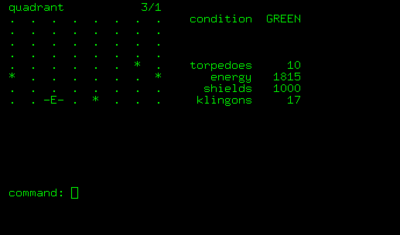Star Trek (computer game, 1971)

Since the early 1970s were a number of Star Trek - computer simulation games programmed presented only with the help of text output. The game principle was implemented on dozens of platforms and operating systems and inspired other games that continued the principle with graphics , network support or otherwise.
An early version of this game was programmed by Mike Mayfield on an SDS Sigma 7 in 1971 and later ported by him to HP BASIC . This version was added to HP's collection of public domain programs and was widely used.
Game flow
The player controls a spaceship Enterprise taken from the Star Trek universe and tries to destroy ships of the enemy Klingons . With the help of text commands, he can navigate in and between sixty-four quadrants, each consisting of eight by eight fields, load and unload protective shields or use sensors and weapons. Actions in the game cost energy, which can, however, be recharged in the starbases scattered around the field.
Ports
BASIC ports
- In the summer of 1973 David H. Ahl ported the HP version from Mayfield to BASIC-PLUS for DEC's RSTS-11 compiler and added little things. Ahl was employed by DEC at the time and was supported by his colleague Mary Cole. Ahl published his version under the name SPACWR in the program collection 101 Basic Computer Games published in 1973 .
- In 1974 Bob Leedom ported the program from 101 Basic Computer Games to the Nova 800 minicomputer from Data General . After he got the game up and running, he modified and expanded the program: The Klingon spaceships could now move; characters known from the TV series have been added to the game; the on-board computer can calculate travel routes and target data for the photon torpedoes; the sixty-four quadrants have been named.
The expanded program came back to David Ahl, who first published it as Super Star Trek in his magazine Creative Computing and in 1978 included it in the revised version of his game collection. The Star Trek brand was used with the permission of the rights holder Paramount Pictures . Scan the source code - Steve Wozniak , developer of the early personal computers Apple I and Apple II, ported "Star Trek" as the very first game for the BASIC interpreter of the MOS Technology 6502 processor used in these systems, which he also developed .
Non-BASIC ports
- Dave Matuszek and Paul Reynolds converted Grady Hicks Taurus BASIC version, which was based on Mayfield's program, but contained innovations, into CDC 6600 Fortran around 1975 . Although the game was initially released as Star Trek , later versions as well as Ahls / Leedom's port were named Super Star Trek . Among other things, new weapons ("Experimental Death Ray", "NOVAMAX warhead"), spy probes, external missions to planets and new opponents have been added to the game. In general, many small changes made the game more complex. In addition, a memory function and a boss key have been integrated.
Tom Almy ported the game to C and released versions for MS-DOS , Windows , Linux , macOS and OS / 2 . From the end of 2004 he also worked with other people on SST2K , a new port of the game.
- In 1988 Nels Anderson published EGATrek, one of the first implementations for MS-DOS that used graphics. The shareware game used protected terms from the Star Trek universe in early versions, which were removed in later releases.
- WinTrek, an early version for Windows computers, was released by Joe Jaworski as shareware in 1992. It is now available as an open source game with WinTrek Enhanced.
- Jason Shankel (a Spore programmer ) wrote a 3D version of Super Star Trek with OpenTrek in the mid-1990s . Open stands for Open Source ( GPL ).
BASIC versions
- TRS-80 version. Playable online
- Commodore Basic V2
- DEC BASIC
- DEC BASIC-PLUS
- OS-8 BASIC - ( PDP-8 )
- TSS-8 BASIC - ( PDP-8 )
- RSTS / e BASIC (DEC)
- Altair BASIC
- Palo Alto Tiny BASIC
- Intellec MDS
- CDC 6000
- PR1ME BASIC / VM
- BASIC-80 CP / M (Microsoft BASIC)
- INTEGER BASIC ( Apple II )
- MS-DOS GW-BASIC . Playable online
- Tandy Color Computer Color BASIC
- BBC BASIC
- AcornSoft ( BBC Micro )
- Exidy Sorcerer BASIC
- HP 2000 BASIC
- TRS-80 Level II BASIC
Non-BASIC versions
- C version (Unix)
- DEC Fortran -IV
- CDC FORTRAN
- VMS Pascal
- Apple UCSD Pascal
- COBOL
- IBM System / 370 Assembler for MVS (versions for VTAM , TSO and ISPF )
- LISP
See also
Individual evidence
- ↑ a b Star Trek. on the website Games of Fame by Maury Markowitz (English).
- ↑ a b David H. Ahl (ed.): Basic Computer Games. Fourth printing, Creative Computing Press, Morristown, New Jersey 1979, ISBN 0-916688-07-0 . Page 157 (English).
- ↑ The program was published in one of the first six editions of Creative Computing, which appeared until December 1975, and can also be found in the Best of Creative Computing compilation . Volume 1. 1976, ISBN 0-916688-01-1 . Pp. 275-281. Digitized at atariarchive.org.
- ↑ Shozo TAKEOKA: Trek in Lisp. Retrieved September 23, 2016 .
Web links
- Story about the version of Mayfield (English)
- Collection of some ports (English)
- EGATrek
- Tom Almys page about Super Star Trek (Fortran) and its ports (English)
- Startrek (English) - Open Source Version (written in Seed7 ) with history and rules
